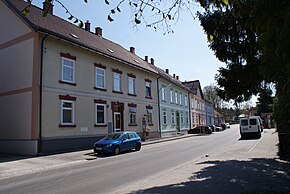Ochsenburg (St. Pölten)
|
|||
| Basic data | |||
| Surface: | 3.71 km² | ||
| Residents: | 354 (December 31, 2015) | ||
| Population density: | 95 inhabitants per km² | ||
| Height: | 244 m above sea level A. | ||
| Post Code: | 3151 | ||
| Geographical location: | 48 ° 8 ' N , 15 ° 38' E | ||
| Cadastral communities | |||
|
|||
| Location in St. Pölten | |||

|
|||
The place Ochsenburg is located in Lower Austria on the Traisen between Wilhelmsburg and St. Pölten , from where it is about seven kilometers away. It has been a district of St. Pölten since its incorporation in 1971 .
Location and breakdown by location
The district of Ochsenburg consists of the cadastral communities Ochsenburg and Dörfl bei Ochsenburg (or localities Ochsenburg and Dörfl ). Before its incorporation in 1971, Ochsenburg belonged to the municipality of St. Georgen am Steinfelde .
The districts of St. Georgen am Steinfelde and Harland border on Ochsenburg . In the south the district borders on Wilhelmsburg , in the east on Pyhra .
history
The first reports from the area come from the 12th century, which testify to a settlement. The residents were mainly active as farmers and winegrowers. At this time the Ochsenburg was first mentioned as the property of the Ochsenburgers . During the first Turkish siege in 1529, a large part of the properties was destroyed because Ochsenburg, unlike St. Pölten and Wilhelmsburg, which were spared, had no city wall.
During the Reformation , the majority of the Ochsenburg population switched to Protestantism. The Thirty Years War revised this development, today the area is largely Catholic. Towards the end of the Peasant Wars , the peasant army in the Ochsenburg area was defeated by the imperial armed forces. In the 17th century, several waves of plague claimed numerous lives. During the 2nd Turkish siege in 1683, the Ochsenburgers fled to the surrounding fortified cities, the area was used as a field camp by the Ottoman army. The place was almost completely burned down.
In 1698 the Ochsenburg Castle was bought by the diocese of St. Pölten . Ochsenburg was also sacked in 1805 and 1809, this time by Napoleon's troops . In 1848 St. Georgen became an independent municipality, Ochsenburg was part of it. After a brief affiliation with the municipality of Wilhelmsburg, the area became independent again in 1850, in an almost unchanged form compared to 1848.
At the end of the 19th century and the beginning of the 20th century, numerous companies were founded, including a spinning mill as a branch of the Harlander Coats . In the years after 1899 the Traisen was regulated and the second Viennese spring water pipeline was built, which created numerous jobs. The expansion of industry in the area also led to an increased demand for workers.
After the collapse of the Austro-Hungarian monarchy in 1918, Ochsenburg was naturally also affected by the political turmoil in Austria after the war, such as the civil war in 1934 and the annexation of Austria in 1938. There were also a large number of arms factories, including the spinning mill.
In 1945, at the end of the Second World War, a large part of the houses in the village were damaged or destroyed by air raids and fighting at the front, and the village was occupied by Soviet troops from 1945 to 1954.
In 1971, St. Georgen and Ochsenburg were incorporated into St. Pölten, which happened against the will of most of the residents. The Traisen Bridge to St. Georgen was built in 1974.
politics
As a district of St. Pölten, Ochsenburg does not have its own municipal council; the mayors up to 1971 can be found in the list of mayors of St. Pölten under St. Georgen.
Culture and sights
Ochsenburg Castle was the summer residence of the Bishop of St. Pölten for a long time . As Bishop Dankesreither's summer guest, Franz Schubert composed parts of the opera “ Alfonso and Estrella ” at the castle.
About three kilometers south of the Ochsenburgerhütte is located on the Rudolfshöhe (592 m), a hiking and excursion destination for the residents of St. Pölten and Wilhelmsburg.
Web links
Individual evidence
- ↑ Magistrate of the City of St. Pölten: Annual Statistical Report 2015.
- ^ Entry on Schubert, Franz Peter in the Austria Forum (in the AEIOU Austria Lexicon )



